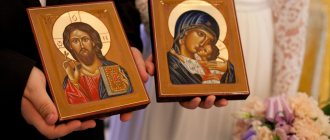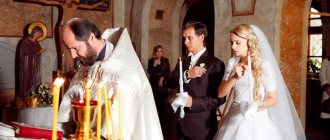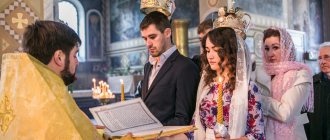Wedding of newlyweds in Orthodoxy: how is the sacrament performed?
It is worth finding out how the wedding procedure works before it begins. This way you will know what to prepare for and what to do during the sacrament. The ceremony itself consists of two stages: the betrothal and the wedding itself.
Engagement
To get engaged, the spouses stand facing the altar: the groom on the right, the bride on the left. The guests sit behind them. The priest gives lighted candles into the hands of the young people, blessing them beforehand. They cross themselves with these candles. It is believed that if they do not go out during the entire ceremony, then the young people will have a happy and long life.
The priest then says prayers and betroths the couple with blessed rings. By the way, they need to be brought to the church in advance for lighting.
After exchanging rings, the couple must go to the middle of the hall and, standing in front of the lectern on a towel, confirm that they are getting married of their own free will.
Wedding
The wedding itself begins with the prayers of the priest, after which he places crowns on the heads of the bride and groom (they are later held by witnesses). Then the priest reads the prayers again and, after the Lord’s Prayer, gives the newlyweds a glass of wine to drink. Everyone should take three sips.
This is followed by a procession around the lectern, in front of which the priest joins the hands of the newlyweds, thereby marking the beginning of their journey together. Then the clergyman takes off the crowns and allows the bride and groom to kiss the icons of the Savior and the Virgin Mary, as well as the cross, in turn. After this, he gives the icons to the young people and gives a parting word. According to tradition, icons and a towel are kept in the family for life.
Folk signs
This ancient and sacred ritual is surrounded by many superstitions. How you treat them is your choice.
Important! The Orthodox Church considers such beliefs sinful and does not approve, but folk wisdom does not arise out of nowhere.
In particular, signs say the following about a wedding dress:
- The dress must be new , and even the bride herself can try it on only once. No long periods of staring at the mirror or taking selfies on Instagram!
- Part of the outfit must be borrowed - a ribbon, a string of pearls, a brooch. In case of trouble in a new family, relatives and friends will definitely help you overcome adversity;
- You shouldn’t let even your best girlfriends or sisters try on a dress , otherwise they will “try on” the bride’s happiness;
- The longer the hem and veil, the longer family happiness will last;
- Gold elements on the dress mean good luck and wealth in the family;
- The stronger the material from which the outfit is sewn, the closer and kinder the relationship between the daughter-in-law and mother-in-law will be;
- You cannot choose separate models consisting of a skirt and a corset , otherwise the family boat may split into two halves;
- The groom should not see the bride in a dress immediately before the ceremony , especially since it is forbidden to choose an outfit together;
- After the wedding, the dress should be carefully stored and not given to anyone. It cannot be worn again or sold - it is your symbol of a happy life and protection from evil.
Cloth
- The ideal clothing for a woman is a floor-length dress or skirt, plain (not black), closed-toed shoes. But this is optional. Sometimes a colored dress can give a completely artistic picture
- Ideal clothing for a man is classic trousers and a shirt (or suit), not shorts (even in the hottest weather), closed shoes (even in the heat)
- We can choose the color scheme of the clothes together. Sometimes it depends on the temple
- Ideal clothing for a child is a light, elegant, monochromatic set (dress) and a white christening shirt, if necessary, a transparent silicone pacifier/bottle, without ropes or colored chains
- If something is missing, wear discreet clothes and take beautiful photographs
Fabrics
Wedding models look luxurious from many materials:
- Natural breathable silk is considered one of the most expensive and beautiful. It looks luxurious, has a shiny structure and a smooth surface.
- Shiny, smooth and iridescent satin is another popular fabric for sewing elegant items.
Most often, “Princess” and “A-line” dresses are found from it, and it is also often combined with other materials - tulle, lace and organza. Satin options are dense and will perfectly warm you in the winter season, cold autumn or chilly spring. You need to be extremely careful with satin, because due to its bright shine it emphasizes the imperfections of the figure, and therefore is recommended only for slender girls. - Light and airy: organza, tulle, tulle, chiffon and veil are also often used for sewing festive dresses. Basically, some individual elements are made from them: a skirt, frills, flounces, ruffles, puffy sleeves, petticoats and high collars. Most often, such delicate dresses are worn for a summer ceremony.
- Romantic lace is a universal material and one of the most fashionable for quite a long time and loved among those getting married of all ages and body types. Lace motifs can vary in shape and pattern. Their main advantage is that they can easily hide any figure flaw. If there is lining fabric, the outfit can be completely openwork; in this case, it does not even require additional decorations, because it already looks impressive and beautiful. This fabric often serves as a trim in a product, for example, on sleeves or a skirt.
What will you need to take with you to the wedding?
- Wedding icons - the Savior and the Mother of God
These icons are used to bless the couple during the sacrament; they are usually kept as family heirlooms. You can buy icons in the Temple, you can use parental icons that were inherited, if there are any in the family. - Wedding candles
These can be purchased in advance from the church, and decorated candles are also sold in wedding stores.
- Wedding rings
Some couples use their own wedding rings for the ceremony, some purchase separate rings, this is the choice of the newlyweds. - Wedding set:
Two towels, napkins for crowns, napkins for candles and napkins for rings. Towels should be made of white or light-colored fabric. The first towel is called the Wedding towel, the newlyweds stand on it during the ceremony, the second is the Union towel, which is used to wrap the hands of the newlyweds. Napkins for candles will protect the newlyweds from wax drops on their dresses. Napkins for the crowns are needed so that the witnesses can use them to hold the crowns over the heads of the newlyweds. In some temples, they are placed on the heads of the bride and groom, and are not required to be held.
wedding in the Church of St. Nicholas the Wonderworker - photo Dmitry Pavlov
Information for witnesses
Witnesses must belong to the same faith as those getting married and treat the wedding ceremony with trepidation.
Previously, guarantors were experienced people who could give advice and knew the joys and sorrows of married life.
Witnesses, as vouchers for the new couple, should know the newlyweds well. They hold crowns over the heads of the bride and groom. And also, witnesses confirm the completed act of wedding with their signatures.
Sacrament of marriage (Wedding)
Wedding is one of the seven Sacraments of the Orthodox Church. Some people prefer to enter into a Church marriage immediately after civil registration, while others prefer to enter into a Church marriage several years later, having firmly established their desire. After all, this is a very serious step in the life of any person and it must be taken, first of all, with the heart.
Stages of the wedding ceremony
First, the Betrothal ceremony of the bride and groom takes place in the vestibule of the temple. The groom stands on the right, the bride on the left. The priest blesses the young couple three times with wedding candles and passes them into the hands of the bride and groom. After saying the prayers, the priest puts rings on the ring fingers of the bride and groom’s right hands and exchanges them three times, thereby symbolizing the newlyweds’ giving to each other. After this, the bride and groom solemnly go to the middle of the temple.
This is where the wedding ceremony itself begins. The newlyweds stand on a white or pink towel. The priest asks about the sincerity of the desire to get married and reads prayers.
After these prayers comes the most important moment. Blessing first the groom, then the bride, the priest crowns the heads of the newlyweds.
Crowns have three symbolic meanings:
- “royal crowns” - as a sign of proclaiming man the King of creation;
- “martyr’s crowns” symbolize the martyrdom of spouses who daily crucify their selfishness in marriage;
- “crowns of the Kingdom of God,” symbolizing the pious path in marriage.
After this, the Gospel and prayers for the newlyweds are read.
Then a common cup of wine is brought out and illuminated. The newlyweds drink from the cup three times, thereby symbolizing the joint sharing of joys and sorrows in married life.
After this, the priest joins the right hands of the newlyweds and, covering them with the stole and his hand, circles the lectern three times, symbolizing the eternal procession that began on this day.
Then the priest takes off his crowns, says prayers and dismisses him. He brings the newlyweds to the Royal Doors, where the newlyweds kiss the wedding pair of icons and the cross. The groom kisses the icon of the Savior, the bride kisses the image of the Mother of God.
This concludes the wedding and everyone present can congratulate the newlyweds.
From us you can order photos and videos of the Sacrament of Wedding. You should first ask permission (blessing) from the priest to take photographs and videotapes of the ceremony. Thanks to the technical characteristics of our professional photographic equipment, we can work in the light conditions of any temple or church, guaranteeing beautiful photographs. Subsequently, from the wedding photo you can make a thematic photo book or slideshow for you.
- Choose a toastmaster - presenter
- View wedding photos from the bride price
- Watch the video of the bride price
- Wedding photo book
- Child baptism photo
Wine
A bottle of Cahors is given to the priest before the ceremony. Later, it is from this that the young people will pour wine into the cup.
A cup of wine is a symbol of common fate, joys and sorrows. You need to drink from it three times, alternately.
Rules for weddings in the Orthodox Church
Church canons have remained unchanged and untouchable for centuries. The wedding ceremony in the Orthodox Church was no exception.
What needs to be done before the wedding:
Buy icons of Jesus Christ and the Blessed Virgin Mary. They are a wedding couple. The appearance of Jesus represents the masculine principle, symbolizing the protector and savior of his wife and future children. The icon of the Most Holy Theotokos personifies the keeper of the hearth, blessing the expectant mother;
Pectoral crosses for young people and invitees. Ideally, when crossing the threshold of the church, guests and newlyweds should already be wearing crosses. If they are lost, crosses can always be purchased directly from the church. By the way, they do not have to be made of precious metals;
Towels and scarves. One towel is placed under the feet of the spouses, the other is tied around the hands of the newlyweds. Ideally, towels should be white and with wedding symbols-amulets applied. Handkerchiefs will be useful for the newlyweds for candles and for witnesses to hold the crown;
Buy Cahors and church candles in advance. The latter must be covered in advance. You can purchase both regular and holiday candles.
Great attention is paid to candles at a wedding; throughout the ceremony, the spouses hold them, wrapped in handkerchiefs. And then they are kept in a hidden place for the rest of their lives. It is believed that wedding candles become a talisman during pregnancy and protect the family from bad thoughts from outside.
Cahors, as a symbol of the blood of Jesus Christ, must also be present at the ceremony;
Wedding rings should be given to the priest before the ceremony. Currently, the church allows the purchase of identical rings made of gold or silver, and jewelry decorated with stones is allowed. If you want to comply with all accepted traditions, then for your husband you should buy a gold ring, symbolizing masculine strength, and for your wife, a silver one, as a symbol of femininity.
Following wedding superstitions, it is useful to flip through the Orthodox wedding calendar in advance. This will help you decide on the date and find out on which days the ceremony is prohibited.
Rings
The permanence and indivisibility of the bond is symbolized by the wedding rings, which the couple always chooses together.
The husband's gold ring represents sunlight, and the woman's ring, made of silver, depicts the likeness of the moon, the luminary that reflects the rays of the sun.
Thus, it is said that the wife serves as a reflection of the husband.
Features of the dress
An exciting event - a wedding, probably one of the most beautiful and mysterious in the world. So that nothing interferes with this ceremony, prepare in advance. What are the requirements for a wedding dress?
Catholic women wear white clothes for weddings. At the same time, Orthodox wedding dresses are more permissive. Beige, light pink, light lilac, and cream tones are suitable for the ritual. The main thing is that the color of the dress for a wedding in a church should not be variegated or dark.
Be sure to choose a modest wedding dress. The product should not be low-cut, bare-backed, or with other provocative elements. Shoulders should be covered. The most popular model with long and ¾ sleeves. In terms of style, the church does not limit the newlywed. The wedding dress can be A-line, fluffy, mermaid or empire style.
Length above the knee is unacceptable. A wedding dress should not be short! A toe-length skirt is the most suitable option. Catholic brides who want to get married purchase an outfit with a train. There is no such requirement in the Orthodox faith.
Length
Miniskirts, as mentioned above, are strictly prohibited, and it is unlikely that the bride herself will want to expose herself too much at such an important, exciting moment of swearing an oath of fidelity to her loved one before God.
Otherwise, the church does not regulate the length of the hem. It is possible to have both a strict midi, the main thing is that the knees do not peek out from under the fabric, or a floor-length maxi, as well as all the intermediate options.
Remember that it is most convenient when the hem rises 2-3 centimeters above the floor, taking into account your shoes. This way you will definitely not step on and tear the dress.
Shoes and accessories
If the bride's clothing does not cover her back and arms, it is necessary to supplement it with the following elements:
A scarf or bolero is an excellent choice for this important event. In the cold season, the accessory will make the bride's appearance modest and provide warmth.
You can cover yourself with a jacket. Elegant models made of silk and satin to match the outfit are suitable.
For a wedding that will take place in the summer, a shawl or cape is suitable. The accessory is made of silk and lace, chiffon fabric
It is important that the selected element looks harmonious with the whole image
Dresses complemented with a hood are popular. This element is made of the finest lace or chiffon and looks very delicate.
In cold winter, it is permissible to wear a coat or short fur coat to church instead of a bolero. These elements should be combined with the outfit in shade.
A wedding dress without sleeves or with short sleeves is complemented by gloves.
Listen to your intuition and your heart when choosing your wedding dress. And then the Sacrament of Wedding will give only bright and positive emotions, and will become an unforgettable day of the union of two loving people!
What to wear: stylists' recommendations
- The main thing your image should talk about is elegance and modesty , so choose a simple style;
- The dress must cover the knees, chest, shoulders and back. In the case of very short sleeves, you cannot do without gloves or a cape;
- Don't forget to cover your head. A scarf in a different shade from the color of the dress will add charming accents to the image that do not go beyond the church dress code;
- Be sure to choose a dress that suits your figure. Tight clothing is basically inappropriate within the walls of a temple, but you should take into account your parameters and height. Plus-size girls don’t need to overuse decor and shiny fabrics, and short brides should avoid floor-length hemlines;
- The color of the wedding dress can be white, but it is better to give preference to cream, cream, ivory and other light shades. Leave acidic and dark colors for another occasion;
- The train at an Orthodox wedding is an extra element. Leave it to the Catholics!
- The most varied fabrics are possible - silk, satin, guipure, organza, velvet, tulle, chiffon.
Preparation for the sacrament of wedding
Such a Russian wedding ceremony as a wedding is a very responsible matter. The sacrament of wedding in the Orthodox Church requires serious preparation not only from spouses, but also from witnesses.
How to prepare recipients for a wedding:
- It is necessary to take communion and confession;
- Observe a three-day fast before the celebration (this also applies to young people);
- Prepare outfits suitable for church. This is especially true for the witness;
- Buy handkerchiefs to hold the crowns over the spouses. As a rule, they are bought by husband and wife, but who knows what can be forgotten in the turmoil of organizing a holiday and getting ready for church?
The recipients and the newlyweds should understand in advance what the essence of the sacrament of wedding is. This will make it easier to navigate what is happening on an important day and not get confused in the sequence of actions.
About behavior in the temple during the Sacrament of Marriage
It often seems as if the bride and groom, accompanied by family and friends, came to the temple not to pray for those getting married, but for the action. While waiting for the end of the Liturgy, they talk, laugh, walk around the church, stand with their backs to the images and iconostasis. Everyone invited to the church for a wedding should know that during a wedding the Church does not pray for anyone else but for two persons - the bride and groom (unless the prayer is said only once “for the parents who brought up”)
The inattention and lack of reverence of the bride and groom to church prayer shows that they came to the temple only because of custom, because of fashion, at the request of their parents. Meanwhile, this hour of prayer in the temple has an impact on the entire subsequent family life
Everyone present at the wedding, and especially the bride and groom, must pray fervently during the celebration of the Sacrament.
Wedding in Orthodoxy: a little history
As we managed to find out, the wedding ceremony in the Orthodox Church was carried out in Rus'. And if now the church seals spiritual marriage only with officially registered couples, then previously it was the other way around: unmarried newlyweds were not recognized as family. The ancestors believed that only before God can one become spouses.
Unfortunately, it is not possible to track changes in the Orthodox Church regarding the sacrament of weddings. However, historians were able to highlight two main moments of the ceremony: the laying of marriage crowns on the heads of the spouses and the use of marriage veils on the territory of the Byzantine Empire. The crown and veil are a symbol of holy faith in the Almighty.
The tradition of holding wedding candles appeared only in the 10th-11th centuries. During the same period, the ceremony began with the words “Christ is crowning,” but already in the 13th century a new tradition appeared to include the words “The servant of God is crowning” in the ritual.
Sacrament of wedding
A couple with candles goes out to the center of the temple, steps onto a veil laid in front of the lectern, where the crowns, cross and Gospel are located. Those getting married express their voluntary consent to marriage, which marks the conclusion of a union according to the flesh.
Next, the union is sanctified by the grace of the Creator.
After reading the prayers, crossing the crowns, and allowing the icons to be kissed, the minister places the crowns on the heads of the couple.
They ask the Lord to marry the bride and groom, and bless them three times.
From the cup, the groom and then the bride take three modest sips of wine. Having covered the couple’s joined hands with the epitrachelion, the minister circles them three times around the lectern.
Then the crowns are removed.
The newlyweds bow their heads and final prayers are read.
The couple kisses modestly.
A cross and icons are served for kissing. This ends the wedding of the newlyweds in the church.
Engagement
Betrothal is the first stage of marriage. Its meaning is to make mutual vows of obligation before the face of God.
For a couple, either a pink or white blanket is laid on the floor. The witnesses take their places. The young people again testify to their desire to enter into an alliance.
Wedding day cards - which one to choose? 150 photos, best ideas, new products + instructions for creating a wedding card with your own handsWedding in winter: pros, cons and features (+45 photos)
Outdoor wedding - organization ideas, tips and recommendations (62 photos + video)
Such voluntary consent is the fundamental basis for concluding a marriage.
Debunking a church marriage
Nothing lasts forever, and a church marriage, unfortunately, can also crack. To dissolve a church marriage, a compelling reason is required: infidelity of one of the spouses, alcohol or drug addiction, sexually transmitted diseases, attempt on the life of a spouse or joint children. To debunk, they write a statement in which they accurately indicate the reason for the divorce. “We didn’t get along” or “not my thing” is not a reason for church divorce.
You will learn more about how to dissolve a church marriage from our thematic articles below. Everyone can get more detailed answers to their questions within the walls of the church.
Beautiful wedding traditions in Russia always attract attention and interest. The portal svadebka.ws is sure that the popularity of the wedding ceremony in the church is dictated not only by fashion, but also by the respect of the couple for their roots and traditions
Hide description
It is forbidden to perform the sacrament
- People married to another person;
- Consanguineous and spiritual relatives;
- For those who have entered into more than three alliances;
- Already married and not dissolved the previous union with the bishop;
- Unbaptized; To non-believers;
- Who enters into an alliance not of his own free will;
- At the time of large and strict fasts; on Easter and Pancake week; in the period between Christmas and Epiphany; before the great, church and twelfth festivals; on Tuesday, Thursday and Saturday; on the eve of or during the period of strict one-day fasts; at night;
- Persons who have clergy;
- Underage; People over marriageable age (women over 60, men over 70);
- If the marriage is not approved by the parents; People with different religions;
- Guilty of the annulment of a previous marriage;
- Civil marriages are considered deprived of God's mercy.
Before the sacrament, the bride and groom fast, confess and receive the sacrament of the Holy Mysteries.
To perform the wedding ceremony you will need:
- Icon of the Savior and Mother of God.
- A couple of rings.
- Candles.
- Blanket under your feet.
On what days are weddings not held in church?
1. Tuesday, Thursday and Saturday - throughout the year;
This is due to the fact that Wednesday and Friday are fast days, which means the nights before are also considered fast days. Sunday is a day dedicated to God, so it is not recommended to get married on Saturday.
2. On the eve of the twelve and great holidays,
such as Christmas Eve, Palm Sunday, Nativity of Christ, Trinity;
3. During multi-day fasts:
Veliky, Petrov, Uspensky and Rozhdestvensky;
4. During Christmastide, Maslenitsa and Easter weeks
;
5. Due to strict one-day fasts:
The Beheading of John the Baptist and the Exaltation of the Holy Cross
6. During the day and during patronal temple holidays
, each church has its own, so the date must be agreed upon in advance with the chosen church.
If the newlyweds are religious and attend a certain church, as a rule, this is the one they choose to conduct the wedding sacrament. Any of the newlyweds can sign up for a wedding, but it is still recommended to come to the temple together 2-3 weeks before the celebration to consult with the priest. They will tell you how to prepare for the sacrament, including spiritually.
wedding in the Epiphany Cathedral in Yelokhov - photo www.sfot.ru
What is needed for a wedding in a church: a complete list
To carry out the ritual, a number of things are necessary, without which the sacrament simply will not take place.
So, what do you need to get married in a church:
- Icon of the Mother of God and Savior. Do your parents or grandparents have these icons? Don't refuse if they offer them to your date;
- Blessed rings. Previously, exclusively smooth rings without engravings and stones were purchased for weddings. Moreover, the bride put a silver ring on the groom, and the groom put a gold ring on the bride. A modern church allows you to choose decorations to suit your taste;
- Wedding candles;
- Cahors (wine);
- Loaf. It is tasted after the ceremony. According to tradition, the mothers of the newlyweds were engaged in baking bread;
- Handkerchiefs. For the young - for holding candles, for witnesses - for crowns;
- Two towels. One will be useful for framing icons, and on the second towel the newlyweds will stand during the sacrament;
- Appropriate clothing for spouses.
You can buy the necessary components separately or purchase a ready-made sacrament kit at the church store. Everything listed above is needed for a church wedding, even if you have been married for a long time.











